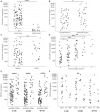Association of Growth Differentiation Factor-15 With Event Cause and Cardiovascular Failure After Pediatric Cardiac Arrest in a Multi-Institutional Trial
- PMID: 37489743
- PMCID: PMC10492992
- DOI: 10.1161/JAHA.123.029972
Association of Growth Differentiation Factor-15 With Event Cause and Cardiovascular Failure After Pediatric Cardiac Arrest in a Multi-Institutional Trial
Keywords: asphyxia; biomarker; child; infant; resuscitation.
Figures

References
-
- Kempf T, Zarbock A, Widera C, Butz S, Stadtmann A, Rossaint J, Bolomini‐Vittori M, Korf‐Klingebiel M, Napp LC, Hansen B, et al. GDF‐15 is an inhibitor of leukocyte integrin activation required for survival after myocardial infarction in mice. Nat Med. 2011;17:581–588. doi: 10.1038/nm.2354 - DOI - PubMed
-
- Rueda F, Cediel G, Garcia‐Garcia C, Aranyo J, Gonzalez‐Lopera M, Aranda Nevado MC, Serra Gregori J, Oliveras T, Labata C, Ferrer M, et al. Growth differentiation factor 15 and early prognosis after out‐of‐hospital cardiac arrest. Ann Intensive Care. 2019;9:119. doi: 10.1186/s13613-019-0593-9 - DOI - PMC - PubMed
-
- Herrmann JR, Fink EL, Fabio A, Au AK, Berger RP, Janesko‐Feldman K, Clark RSB, Kochanek PM, Jackson TC. Serum levels of the cold stress hormones FGF21 and GDF‐15 after cardiac arrest in infants and children enrolled in single center therapeutic hypothermia clinical trials. Resuscitation. 2022;172:173–180. doi: 10.1016/j.resuscitation.2021.11.016 - DOI - PMC - PubMed
-
- Fink EL, Kochanek PM, Panigrahy A, Beers SR, Berger RP, Bayir H, Pineda J, Newth C, Topjian AA, Press CA, et al. Association of blood‐based brain injury biomarker concentrations with outcomes after pediatric cardiac arrest. JAMA Netw Open. 2022;5:e2230518. doi: 10.1001/jamanetworkopen.2022.30518 - DOI - PMC - PubMed
Publication types
MeSH terms
Substances
Grants and funding
LinkOut - more resources
Full Text Sources
Medical

